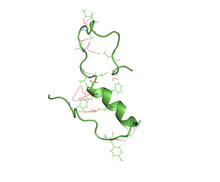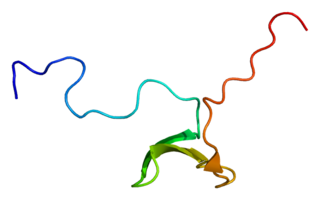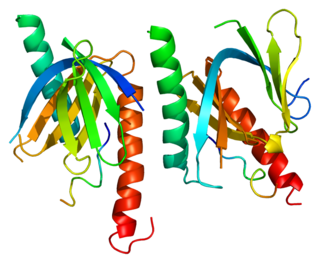Amyloid precursor like protein 2, also known as APLP2, is a protein encoded by the APLP2 gene in humans. [5] [6] APLP2 along with APLP1 are important modulators of glucose and insulin homeostasis. [7]
Amyloid precursor like protein 2, also known as APLP2, is a protein encoded by the APLP2 gene in humans. [5] [6] APLP2 along with APLP1 are important modulators of glucose and insulin homeostasis. [7]
The human APLP2 gene is located on the long (q) arm of chromosome 11 at region 2 band 4, from base pair 130, 069, 821 to base pair 130, 144, 811 (GRCh38.p7). [5]
APLP2 consists of 763 amino acids, with 31 amino acids making up the signal peptide and 732 amino acids making up the chain of the protein. [8]
The extracellular domain (residues 32-692) contains the E1 domain, E2 domain, and BPTI/Kunitz inhibitor domain. [8] [9] The E1 domain contains two independent folding units, the growth factor-like domain (GFLD) and the copper-binding domain (CuBD). [9] GFLD has a highly charged basic surface and a highly flexible region consisting of an N-terminal loop formed by a disulphide bridge. [9] CuBD consists of an alpha-helix that is tightly packed on a triple-stranded beta-sheet. [9]
The E2 domain is the largest subdomain of APLP2 and consists of six alpha-helixes. [9] The N-terminal double stranded coiled coil structure of the first monomer of E2 packs against the C-terminal triple stranded coiled coil structure of the second monomer. [9]
The BPTI/Kunitz inhibitor domain (residues 306-364) [8] is ‘Cys-rich’ and is capable of inhibiting several proteases. [10]
The ectodomain of APLP2 is dimeric and contains multiple binding sites for metal ions and components of the extracellular matrix. [9] These bindings site can bind copper, zinc, collagen and heparan sulfate. [9]
The transmembrane region of APLP2 (residues 693-716) is helical in structure. [8]
The cytoplasmic domain (resides 717-763) [8] contains a YENPTY sequence suggesting a duel function of the domain. [9] The NPxY motif can function as a signal for endocytosis or the sequence can function to mediate binding of various interactive partners. [9]
APLP2 associates with antigen presentation molecules like MHC class I molecules and regulates their surface expression by enhancing endocytosis. [11] [12]
APLP1 and APLP2 double knockout mice display hypoglycemia and hyperinsulinemia indicating that these two proteins are important modulators of glucose and insulin homeostasis. [7] APLP2 has also been shown to regulate development of the brain by regulating migration and differentiation of neural stem cells. [13]
Double mice knock outs of APLP2 and its homologues, APP and APLP1 have shown a strong indication that APLP2 has the key physiological role among the family members. [14] APLP2/APP double knock out mice and APLP2/APLP1 double knock out mice each show a lethal phenotype (postnatal day 1), whereas APLP1/APP double knock out mice are apparently normal, demonstrating the importance of the APLP2 protein. [14]
APLP2 plays a role in synaptic plasticity, functioning to promote neurite outgrowth, neural cell migration and copper homeostasis. [14] Analysing the neurons and networks of APP/APLP2 double knock out mice using stem cell-derived neurons and slice cultures, shows deficient excitatory synaptic transmission in this genotype. [15] Moreover, APLP2 together with APP has been demonstrated to exhibit presynaptic and postsynaptic functions in synaptogenesis and maintenance of synapses. [16]
APLP2 has shown to act as a cargo receptor in axonal transport for intact proteins. [17]
APLP2 is part of a family of mammalian membrane proteins along with APLP1 and amyloid precursor protein (APP). [18] Since APP plays a key role in the molecular pathology of Alzheimer’s disease (AD), it has been hypothesized that APLP2 also plays a role in AD pathogenesis. [19] The amyloid β peptide (Aβ) that is present on APP has been shown to cause neurotoxic effects leading to AD. [20] Although the Aβ sequence is not present on APLP2, it has been suggested that APLP2 and APP share a functional redundancy whereby both proteins interplay with one another to exhibit physiological functions to do with synapse formation. [19]

Beta-secretase 2 is an enzyme that cleaves Glu-Val-Asn-Leu!Asp-Ala-Glu-Phe in the Swedish variant of Alzheimer's amyloid precursor protein. BACE2 is a close homolog of BACE1.

Amyloid beta denotes peptides of 36–43 amino acids that are the main component of the amyloid plaques found in the brains of people with Alzheimer's disease. The peptides derive from the amyloid-beta precursor protein (APP), which is cleaved by beta secretase and gamma secretase to yield Aβ in a cholesterol-dependent process and substrate presentation. Both neurons and oligodendrocytes produce and release Aβ in the brain, contributing to formation of amyloid plaques. Aβ molecules can aggregate to form flexible soluble oligomers which may exist in several forms. It is now believed that certain misfolded oligomers can induce other Aβ molecules to also take the misfolded oligomeric form, leading to a chain reaction akin to a prion infection. The oligomers are toxic to nerve cells. The other protein implicated in Alzheimer's disease, tau protein, also forms such prion-like misfolded oligomers, and there is some evidence that misfolded Aβ can induce tau to misfold.

Amyloid-beta precursor protein (APP) is an integral membrane protein expressed in many tissues and concentrated in the synapses of neurons. It functions as a cell surface receptor and has been implicated as a regulator of synapse formation, neural plasticity, antimicrobial activity, and iron export. It is coded for by the gene APP and regulated by substrate presentation. APP is best known as the precursor molecule whose proteolysis generates amyloid beta (Aβ), a polypeptide containing 37 to 49 amino acid residues, whose amyloid fibrillar form is the primary component of amyloid plaques found in the brains of Alzheimer's disease patients.

Beta-secretase 1, also known as beta-site amyloid precursor protein cleaving enzyme 1, beta-site APP cleaving enzyme 1 (BACE1), membrane-associated aspartic protease 2, memapsin-2, aspartyl protease 2, and ASP2, is an enzyme that in humans is encoded by the BACE1 gene. Expression of BACE1 is observed mainly in neurons and oligodendrocytes.

Protein kinase RNA-activated also known as protein kinase R (PKR), interferon-induced, double-stranded RNA-activated protein kinase, or eukaryotic translation initiation factor 2-alpha kinase 2 (EIF2AK2) is an enzyme that in humans is encoded by the EIF2AK2 gene on chromosome 2. PKR is a serine/tyrosine kinase that is 551 amino acids long.
The biochemistry of Alzheimer's disease, the most common cause of dementia, is not yet very well understood. Alzheimer's disease (AD) has been identified as a proteopathy: a protein misfolding disease due to the accumulation of abnormally folded amyloid beta (Aβ) protein in the brain. Amyloid beta is a short peptide that is an abnormal proteolytic byproduct of the transmembrane protein amyloid-beta precursor protein (APP), whose function is unclear but thought to be involved in neuronal development. The presenilins are components of proteolytic complex involved in APP processing and degradation.

Presenilins are a family of related multi-pass transmembrane proteins which constitute the catalytic subunits of the gamma-secretase intramembrane protease protein complex. They were first identified in screens for mutations causing early onset forms of familial Alzheimer's disease by Peter St George-Hyslop. Vertebrates have two presenilin genes, called PSEN1 that codes for presenilin 1 (PS-1) and PSEN2 that codes for presenilin 2 (PS-2). Both genes show conservation between species, with little difference between rat and human presenilins. The nematode worm C. elegans has two genes that resemble the presenilins and appear to be functionally similar, sel-12 and hop-1.

Low-density lipoprotein receptor-related protein 8 (LRP8), also known as apolipoprotein E receptor 2 (ApoER2), is a protein that in humans is encoded by the LRP8 gene. ApoER2 is a cell surface receptor that is part of the low-density lipoprotein receptor family. These receptors function in signal transduction and endocytosis of specific ligands. Through interactions with one of its ligands, reelin, ApoER2 plays an important role in embryonic neuronal migration and postnatal long-term potentiation. Another LDL family receptor, VLDLR, also interacts with reelin, and together these two receptors influence brain development and function. Decreased expression of ApoER2 is associated with certain neurological diseases.

Presenilin-1(PS-1) is a presenilin protein that in humans is encoded by the PSEN1 gene. Presenilin-1 is one of the four core proteins in the gamma secretase complex, which is considered to play an important role in generation of amyloid beta (Aβ) from amyloid-beta precursor protein (APP). Accumulation of amyloid beta is associated with the onset of Alzheimer's disease.

Low density lipoprotein receptor-related protein 1 (LRP1), also known as alpha-2-macroglobulin receptor (A2MR), apolipoprotein E receptor (APOER) or cluster of differentiation 91 (CD91), is a protein forming a receptor found in the plasma membrane of cells involved in receptor-mediated endocytosis. In humans, the LRP1 protein is encoded by the LRP1 gene. LRP1 is also a key signalling protein and, thus, involved in various biological processes, such as lipoprotein metabolism and cell motility, and diseases, such as neurodegenerative diseases, atherosclerosis, and cancer.

Granulin is a protein that in humans is encoded by the GRN gene. Each granulin protein is cleaved from the precursor progranulin, a 593 amino-acid-long and 68.5 kDa protein. While the function of progranulin and granulin have yet to be determined, both forms of the protein have been implicated in development, inflammation, cell proliferation and protein homeostasis. The 2006 discovery of the GRN mutation in a population of patients with frontotemporal dementia has spurred much research in uncovering the function and involvement in disease of progranulin in the body. While there is a growing body of research on progranulin's role in the body, studies on specific granulin residues are still limited.

Amyloid beta A4 precursor protein-binding family B member 1 is a protein that in humans is encoded by the APBB1 gene.

Amyloid beta A4 precursor protein-binding family A member 1 is a protein that in humans is encoded by the APBA1 gene.

Amyloid precursor like protein 1, also known as APLP1, is a protein encoded by the APLP1 gene in humans. APLP1 along with APLP2 are important modulators of glucose and insulin homeostasis.

Amyloid beta A4 precursor protein-binding family A member 2 is a protein that in humans is encoded by the APBA2 gene.

NEDD8-activating enzyme E1 regulatory subunit is a protein that in humans is encoded by the NAE1 gene.

Brain mitochondrial carrier protein 1 is a protein that in humans is encoded by the SLC25A14 gene.

Microtubule-associated protein 6 (MAP6) or stable tubule-only polypeptide is a protein that in humans is encoded by the MAP6 gene.

Rudolph Emile 'Rudy' Tanzi a professor of Neurology at Harvard University, vice-chair of neurology, director of the Genetics and Aging Research Unit, and co-director of the Henry and Allison McCance Center for Brain Health at Massachusetts General Hospital (MGH).

Phospholipase D3, also known as PLD3, is a protein that in humans is encoded by the PLD3 gene. PLD3 belongs to the phospholipase D superfamily because it contains the two HKD motifs common to members of the phospholipase D family, however, it has no known catalytic function similar to PLD1 or PLD2. PLD3 serves as a ssDNA 5' exonuclease in antigen presenting cells. PLD3 is highly expressed in the brain in both humans and mice, and is mainly localized in the endoplasmic reticulum (ER) and the lysosome.